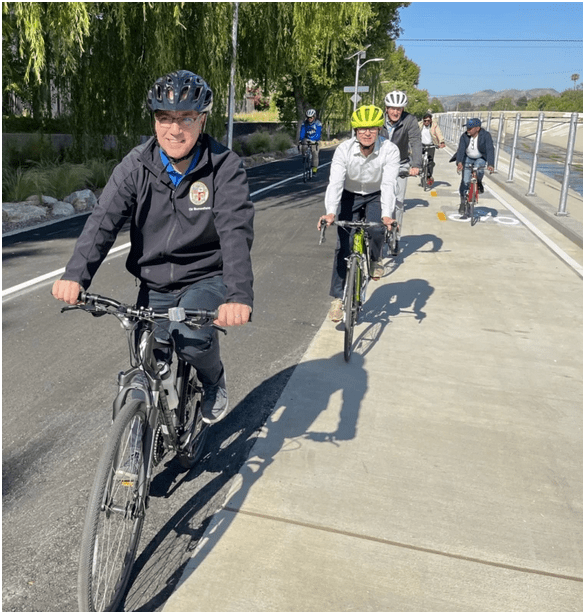
This morning in Canoga Park, L.A. City Councilmember Bob Blumenfield celebrated the grand opening of the newest segment of the Los Angeles River path. City and community leaders spoke before a ribbon-cutting and ceremonial bike ride. Blumenfield credited the city's Transportation Department (LADOT), Bureau of Street Services (Streets L.A.), and the project contractor, United Construction and Landscaping, for completing the project on budget and a year ahead of schedule.
Blumenfield praised the new bikeway as a component of the "incredible linear park" that revitalization projects are implementing along the 51+ mile long river.
Today I welcomed bike advocates and city leaders to unveil the newest portion of the LA River Bike Path. Located at the headwaters of the River from Owensmouth Ave to Mason Ave, this 1.5 mile of new path connects to established portions we helped create over the past few years. pic.twitter.com/iaj6N3kPfV
— Bob Blumenfield (@BobBlumenfield) April 21, 2022
The new path starts at what is called the L.A. River's headwaters - the confluence of Bell Creek and Calabasas Creek - right behind Canoga Park High School. Though there are miles of upstream tributaries, this is the furthest upstream point where the Los Angeles River is called the Los Angeles River. The river goes east-west through the Valley, then turns north-south in downtown L.A., flowing into the Pacific in Long Beach. There are bikeways along only about half of the length of the river currently, with L.A. City, Metro, and the County working on projects that would fill in the gaps to extend paths the entire length.
The new path is located on the concrete-reinforced south bank of river. It extends 1.3 miles from Owensmouth Avenue to Mason Avenue, including undercrossings at Canoga Avenue / G Line and De Soto Avenue. The new section of path connects to an existing stretch of river path that Blumenfeld opened in 2014. The West Valley river bikeway now extends just over three miles - from Owensmouth to Vanalden Avenue.
The $6 million dollar project was primarily funded by a $5.4 million grant from the state Active Transportation Program (ATP).
The new path adds a bicycling component to this stretch's existing river parkway features. The north side of the river there features a decomposed granite walking trail with extensive native landscaping. On the south side, pedestrians can walk along the bikeway, or, in wider areas, can utilize an intermittent parallel meandering walk path - also with extensive native plantings.
Blumenfield announced two new initiatives that would extend the river path even further downstream.
Next week the city council expects to approve environmental studies/plans (a mitigated negative declaration - MND, Council File 22-0247) for extending the path downstream into the Sepulveda Basin, specifically three miles from Vanalden to Balboa Boulevard. That project, which Blumenfield now shares with Councilmember Nithya Raman and Council President Nury Martinez, is funded and anticipated to begin construction in the coming fiscal year, which starts in July.
Blumenfield is also supporting a possible ~$200 million California state budget earmark, being sought by Assemblymember Laura Friedman, for completing the Valley portion of the river bike path in advance of the 2028 Olympics. Blumenfield shepherded official city support for the earmark (Council File 22-0002-S18). Last year, Friedman secured $15 million in earmark funding for river path projects in Glendale and North Atwater, but at the same time, in blocking high-speed rail electrification funds, she blocked $7.6 billion worth of green transportation funds that would have supported active transportation projects - like the river path - and acceleration of L.A. transportation infrastructure improvements supporting the Olympics.
Blumenfield also touted further active transportation improvements - including a connection between the G Line path and River path - coming to Canoga Park under a recent ATP grant.






